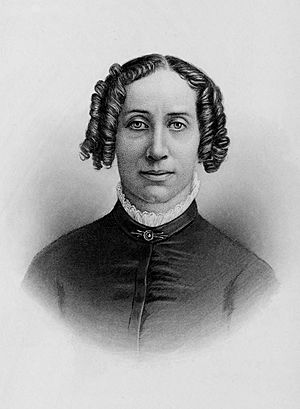Clarina I. H. Nichols facts for kids
Quick facts for kids
Clarina I. H. Nichols
|
|
|---|---|
 |
|
| Born | January 25, 1810 |
| Died | January 11, 1885 (aged 74) California
|
| Nationality | American |
| Occupation | journalist lobbyist public speaker |
Clarina Irene Howard Nichols (born January 25, 1810 – died January 11, 1885) was an important American woman. She worked as a journalist, a lobbyist (someone who tries to influence laws), and a public speaker. Clarina was involved in three major movements in the mid-1800s: the temperance movement (which aimed to reduce alcohol use), the abolition movement (which worked to end slavery), and the women's movement (which fought for equal rights for women).
Even though she was very well-known in her time, Clarina Nichols was largely forgotten after 1900. Recently, people have started to look at her contributions to equal rights again.
Contents
Clarina's Life Story
Early Life and Work
Clarina Nichols was born in West Townshend, Vermont. Her family was quite well-off. However, she faced some tough times early in her life after a difficult first marriage. To support herself and her children, she had to work. Women at that time were paid much less than men for the same work, sometimes only half or a third of what men earned.
She started writing for a newspaper in Brattleboro, Vermont, called the Windham County Democrat. She later married the editor and publisher, George Nichols. When he became ill, Clarina quietly took over running the newspaper. This new job helped her learn about many important movements of the day. These included temperance, women's rights, and the fight against slavery. She became a strong supporter of many of these causes.
Fighting for Women's Rights
Clarina helped start the women's rights movement in the eastern United States. In October 1852, she helped organize the first of several petitions. These petitions asked the Vermont legislature to give women the right to vote in school meetings. This was an important step towards women having more say in their communities.
Moving to Kansas and Continued Activism
In 1854, the Kansas–Nebraska Act was passed. This law threatened to allow slavery to spread into new territories outside the South. Because of this, Clarina Nichols moved her family to Kansas. There, she became a pioneer and an activist. Her hard work helped Kansas become a leader in women's rights. She earned the respect of famous women like Susan B. Anthony and Elizabeth Cady Stanton.
Clarina Nichols lived a very busy life. She worked as a teacher, speaker, editor, writer, and even a farmer. She also acted as a lay doctor and lawyer, a government clerk, and a helper in a home for black children and widows who needed help.
Helping on the Underground Railroad
Clarina Nichols was also an active "Station Master" and "Conductor" on the Underground Railroad. This was a secret network that helped enslaved people escape to freedom. She lived in Quindaro, Kansas, and helped many people.
She once wrote a letter about a time when a freedom seeker named Caroline came to her house. Caroline's slave master and other slave hunters were camped nearby, looking for her. Clarina hid Caroline in an empty underground storage area (a cistern) overnight. As soon as it was safe, she helped Caroline continue her journey north to freedom.
Clarina Nichols kept fighting for what she believed in until the end of her life. She died in 1885 in California.
See also
- Aurelius O. Carpenter, her son

